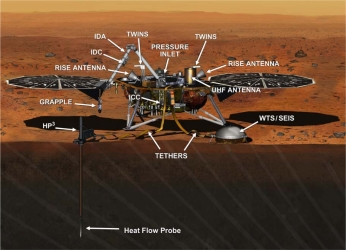InSight instrument host
mission specific
Lander basic description
The InSight lander has a high level of heritage from the Phoenix spacecraft with upgrades due to parts obsolescence, payload accommodations, and extended operations. InSight is a highly centralized flight system designed around a core lander that controls all functions throughout all the mission phases. The lander contains the avionics (computer and telecommunications hardware) and power electronics. The first figure below shows the location of some of the major components of the lander in an immediate post-landing configuration where the payloads are all still located on the deck. The second figure below shows the configuration of the lander and location of the instruments after the payloads have been deployed.
InSight Lander with payload instruments deployed.
InSight lander deck (prior to payload deployment) and avionics compartment (thermal enclosure) components. Lander components are labeled in black with payload components in blue.
The overall characteristics of the lander include a total mass of about 390 kg, a lander deck size of approximately 1.5m x 1.9m and height of ~0.5m to the top of the lander deck. The robotic arm can extend an additional 1.86 m above the lander deck. The lander supports the science instrument payload investigations, provides high-speed computational capability and substantial data storage, and provides X-band Direct-to-Earth (DTE) and Direct-from-Earth (DFE) telecommunications as well as the ability to communicate via UHF with Mars Reconnaissance Orbiter and Mars Odyssey (which will store and relay the data to Earth).
Energy
Power is supplied to the lander by two solar arrays with a total surface area of 5.16 m2 that are deployed immediately after landing. The final orientation and tilt of the lander, array dust covering, and local atmospheric tau measurements all affect the power available from the arrays. The maximum expected energy collected with the solar arrays over one Martian sol in an ideal situation is ~3600 W-hr. Under worst-case atmospheric dust conditions and with conservative tilt and dust accumulation on the solar arrays, the energy collected could be as little as ~750 W-hr; however the combined conditions that would result in this little energy are relatively unlikely. The arrays are supported by two lithium ion batteries (total expected storage capacity of 48 A-hr at the start of the surface mission) that are expected to cycle through a charge/discharge cycle on a per sol basis, with a maximum allowed depth of discharge of 60%. Due to energy limitations the lander is expected to sleep the majority of the time, waking up every 3 hours to perform fault protection diagnostics as well as twice per sol for scheduled full wakeups for communications and transferring science data from the payloads. While the lander sleeps, the payloads are expected to nominally remain continuously powered and collecting data. In circumstances in which, due to dust storms or heater loads during the cold season, energy consumption must be reduced, payloads will be powered off as required to maintain essential operations and lander energy balance. It is expected that under worst-observed atmospheric dust conditions and with conservative tilt and dust accumulation on the solar arrays, the number of sols spent with reduced instrument activity to conserve energy (including dust storm survival, with all instruments off) will total fewer than 180 sols.
Telecom
The surface telecommunications system uses three antennae, an east and a west medium-gain X-band antenna for Direct-to/from-Earth communications and a UHF helix antenna for relay communications with an orbiter. The nominal mission plan during the deployment phase is to utilize the east X-band antenna to uplink directly from Earth to the lander, whereas the plan during the science monitoring phase is to uplink via relay orbiters. Downlink from the lander to Earth throughout the mission will nominally be accomplished via relay through either Mars Reconnaissance Orbiter or Mars Odyssey with two passes a day. If for any reason the UHF return link is not available, data can be downlinked via the X-band assets but at a much slower rate. The average downlink via orbiter relays is expected to be >90 Mbits/sol and the average uplink via relays will be several hundred Mbits/sol.
see also

